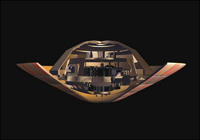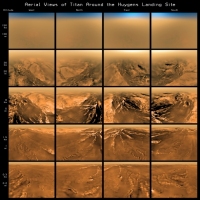Huygens legacy conference to mark fifth anniversary of Titan landing
8 January 2010
On 14 January 2005 the European Space Agency's Huygens probe separated from the Cassini spacecraft and landed on Saturn's moon Titan. The touchdown on the surface of Titan marked the first, and so far only, landing of a man-made probe in the outer Solar System. To mark the fifth anniversary of this remarkable event, scientists will gather from 13-15 January at the CosmoCaixa science museum in Barcelona, Spain, to review the key scientific and engineering achievements of Huygens, to evaluate the current understanding of Titan, and to consider future Titan exploration missions.
 |
|
The Huygens probe Credit: ESA |
 |
|
Views of Titan from Huygens |
In addition, participants will review expectations for the ongoing Cassini Equinox Mission. The primary Cassini mission, which ran from 1 July 2004 to 30 June 2008, included 45 flybys of Titan. Since 1 July 2008 the Cassini Equinox Mission continues the tour of the Saturnian system. A total of 26 Titan flybys are planned, of which 20 had been completed by the end of 2009. The remaining 6 will be carried out in 2010, the next one taking place on 12 January.
The conference will also provide an opportunity for scientists to take stock of the current understanding of Titan in the light of the Huygens and Cassini studies and to discuss scientific priorities for future missions to Titan.
Preserving the Huygens Legacy
Participants will use this occasion to examine ways of preserving the unique scientific and engineering knowledge obtained during the Huygens mission and of transferring it to future generations of Solar System explorers. This topic will be the subject of a specific ESA technical study to be conducted this year.
Conference details
The Huygens Legacy and Future Titan Exploration conference will be held at the CosmoCaixa science museum in Barcelona, Spain, from 13-15 January 2010. The conference is organised around a series of introductory lectures, invited and contributed talks, and poster sessions. The conference is open to all; there is no conference fee but participants must register.
A public event celebrating the landing of Huygens on Titan will be held on the afternoon/evening of 14 January in the Auditorium of the CosmoCaixa.
A video recording of the meeting, along with copies of all presentation material will be made available online after the conference.
For further details please visit the conference website (see link in right-hand menu).
For further information:
Jean-Pierre Lebreton, ESA Huygens Project ScientistEmail: Jean-Pierre.Lebreton
 esa.int
esa.int


